mobile View, to the German Version tap the flag


- Czechoslovakian Republic (Czechoslovakia)
- 1918–1938 and 1945–1992 existing, Czechia and Slovakia unifying state
- own name 1990–1992: Ceskoslovenská Republika (Ceskoslovensko)
- Links: Czechia / Slovakia
• Flags
• Meaning/Origin of the Flag
• Coat of Arms
• Meaning/Origin of the Coat of Arms
• Aircraft Roundel
• Numbers and Facts
• History
• Origin of the Country's Name

1918–1920,
National flag of Czechoslovakia,
ratio = 2:3,
Source, by:
Flags of the World






1920–1992,
National flag of Czechoslovakia,
ratio = 2:3,
Source, by: Flags of the World





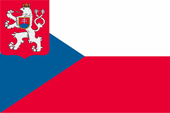
1935–1939, 1945–1955,
Flag of the patrol boats,
ratio = 2:3,
Source, by: Flags of the World



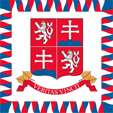
1990–1992,
Standard of the President of Czechoslovakia,
Source, by: Flags of the World,
Wikipedia (D)




19th century,
Bohemian colours of the Czechs,
ratio = 2:3,
Source, by: Flaggen und Wappen der Welt



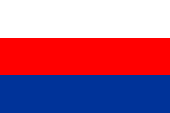
19th century,
Colours of the Slavs in Moravia,
ratio = 2:3,
Source, by: Flaggen und Wappen der Welt



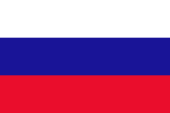
since 1868,
Colours of the Slovaks,
ratio = 2:3,
Source, by: Flaggen und Wappen der Welt




1990–1992,
Flag of the Czech Republic within Czechoslovakia,
ratio = 2:3,
Source, by: Flags of the World




1990–1992,
Flag of the Slovak Republic within Czechoslovakia,
ratio = 2:3,
Source, by: Flags of the World




The flag of Czechoslovakia was introduced on 30th of March in 1920, and was taken over as flag of Czechia in preparation for the separation of Slovakia on 17th of December in 1992. It shows two horizontal stripes in white and red and on the pole a blue until the middle of the flag reaching isosceles triangle. The colours white and red are the since the 12th century known Bohemian colours (white lion on red), the blue triangle should represent Slovakia.
Many Slavic nations create on the 19th century own flags – in context with a growing Slavic nationalism. Thereby played the Panslavism an important roll, a political movement of the 18th/19th century, which would unite all Slavs in one nation. The most Slavic nations however lived in this times under Austrian, Turkish or even German rule. The Panslavism saw in Russia a model, because the Russians were, apart from Montenegro, the only free Slavic nation. In this way the colours of the Russian flag became to an idol of the Panslavists, and in the end to a colour's pattern in the designing of the flags of many Slavic nations. Those flags carried and carry except few exceptions the Russian colours white, blue and red as mutual attribute. From there this colour's combination is named "Panslavic Colours". The three colours had been shown for the first time in the year 1848 on the Slavic Congress in Prague, but in a lengthwise striped tricolour. They represented the Czech and the Slovaks. The Slavs in Moravia finally preferred the horizontal colour combination of white, red and blue, which can also be traced back to the old (and nowadays reused coat of arms of Moravia) from before 1462.
Anyhow was introduced as the first flag of Czechoslovakia, in recomendation of the national council of Czechoslovakia, a horizontally striped bicolour in the bohemian colours white and red on 28th of October in 1918, the day of founding of the state. But the new neighbouring states of Czechoslovakia, Austria and also Poland, used the same colours, so that it was necessary to bring about a better differentiation. Moreover Slovakia was not represented in the existing flag. Because of that was – after many debates – officially introduced the well known flag of Czechoslovakia on 30th of March in 1920.
Source: Flags of the World,
Die Welt der Flaggen,
Flaggen und Wappen der Welt


1920–1938, 1945–1960,
Lesser coat of arms of Czechoslovakia
Source, by: See page for author / CC BY-SA

1918–1938, 1945–1960,
Greater coat of arms of Czechoslovakia,
Source, by: Shazz / CC BY-SA

1918–1938, 1945–1960,
Escutcheon of the greater coat of arms of Czechoslovakia,
Source, by: Shazz / CC BY-SA

1920–1939, 1945–1960,
Middle coat of arms of Czechoslovakia,
Source,
nach: See page for author / CC BY-SA

1939–1945,
Greater coat of arms of the Protectorate of Bohemia and Moravia,
Source, by:
Fornax / Public domain

1960–1990,
Lesser coat of arms of Czechoslovakia,
Source, by:
Wikipedia (EN)
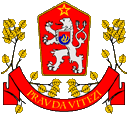
1960–1990,
Greater coat of arms of Czechoslovakia,
Source, by:
Wikipedia (EN)

1990–1992,
Coat of arms of Czechoslovakia,
Source, by:
Wikipedia (D)
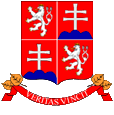
1990–1992,
Coat of arms of Czechoslovakia on the standard of the president,
Source, by:
Wikipedia (D)

The greater and partially the lesser coat of arms of Czechoslovakia showed (except between the years 1960 and 1990) always the heraldry of the many historic regions which had been merged to Czechoslovakia in 1918: Bohemia, Moravia, Silesia, Slovakia, Carpatho-Ukraine, Teschen, Troppau and Ratibor. The lesser coat of arms combined mostly the double-tailed bohemian lion with a chest shield which contained the historic coat of arms of Slovakia, except between the years 1960 and 1990. The Motto in the banner was: "Pravda vitezi", since 1990 even in Latin: "Veritas vincit" → "The truth will win".
Source: Wikipedia (EN),
Volker Preuß

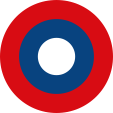
1918–1920,
Aircraft Roundel,
Source, by: Wikipedia (EN)
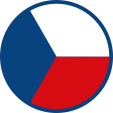
1920–1938, 1945–1992,
Aircraft Roundel,
Source, by: Wikipedia (EN)

Area (1983): 49.373 square miles
Inhabitants: 15.400.000 (1983), thereof 64% Czech and Moravians, 31% Slovaks, 3,8% Hungarians, 0,4% Polish, 0,4% Germans, 0,3% Ukrainians, 0,1% Russians
Density of Population: 312 inh./sq.mi. (1983)
Capital: Prag (Engl.: Prague, Czech: Praha), 1.200.000 inh. (1983)
official Languagen: Czech, Slovakian
other Languages: German, Hungarian
Currency: 1 Czechoslovakian Koruna (Krone, Kcs) = 100 Háleru (Heller)
Time Zone: GMT + 1 h
Source: Länder der Erde

History of Bohemia to 1918 (→ click here)
History of Moravia to 1918 (→ click here)
History of Austrian Silesia to 1918 (→ click here)
History of Slovakia (→ click here)
History of Carpatho-Ukraine (→ click here)
28th of October 1918 · formation of Czechoslovakia by merger of Bohemia, Moravia, Austrian Silesia, Slovakia and the Carpatho-Ukraine
29th of September 1938 · Czechoslovakia cedes Sudetenland to the German Empire
2nd of October 1938 · Poland occupys and annexes the Teschener Land
14th of March 1939 · the Slovak People's Party proclaims under Josef Tiso (1887–1947) the Slovakian Republic, disintegration of Czechoslovakia, Carpatho-Ukraine bekommes annexed by Hungary
15th of March 1939 · invasion of German troops, establishment of the Protectorate of Bohemia and Moravia
9th of May 1945 · takeover by ex-president Beneš, restoration of Czechoslovakia
1945–1948 · expulsion of 2,75 millions of Germans and hundred thousends of Hungarians with hundred thousends of dead persons
1946 · elections, 38% votes for the communists
1948 · elimination of the civic wing, withdrawal of Beneš, communist seizure of power
1968 · reform movement, "Prague Spring", suppressed by force by Soviet troops
24th of November 1989 · resignation of the communist government
9th of June 1990 · elections
1992 · arrangements for dissolution of Czechoslovakia
1st of January 1993 · disintegration of Czechoslovakia, independence for Czechia and Slovakia
Source: Wikipedia (D),
World Statesmen,
Discovery '97,
Weltgeschichte

The name "Czechoslovakia" merges the two geographic terms "Czechia" and "Slovakia" to one word.
Source: Volker Preuß


![]()









































